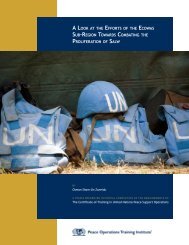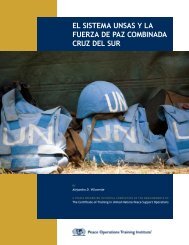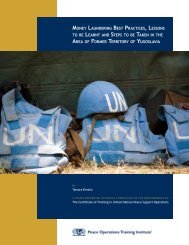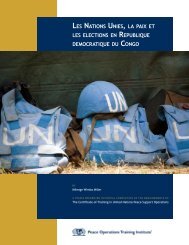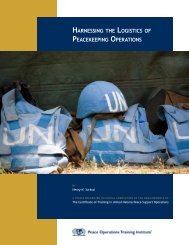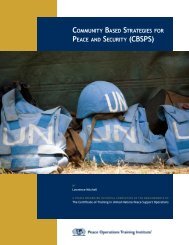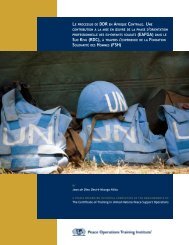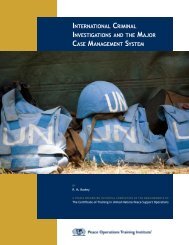COTIPSO Operating Framework (PDF) - Peace Operations Training ...
COTIPSO Operating Framework (PDF) - Peace Operations Training ...
COTIPSO Operating Framework (PDF) - Peace Operations Training ...
You also want an ePaper? Increase the reach of your titles
YUMPU automatically turns print PDFs into web optimized ePapers that Google loves.
COURSE AUTHOR: Mr. Antoine Bouvier, Legal Adviser in the International Committee of the Red Cross AdvisoryService on IHL, Geneva.LOGISTICAL SUPPORT TO UN PEACEKEEPING[In English, French, and Spanish]This course introduces students to logistics operations in UN peace operations. This basic course gives the backgroundand rationale behind United Nations <strong>Peace</strong>keeping logistics, the strategy employed in the field and at Headquarters,introduces the mission life cycle, explains how financial support is gained, and introduces the different components thatmake up integrated logistics support in a field mission. Eight lessons, 248 pages.COURSE AUTHOR: Mr. Kamran Baig, Coordinator of Common Services at the UN Office at Nairobi (UNON), formerlyserved at ONUB, UNMIL, UNLB, and UNMIBH.OPERATIONAL LOGISTICAL SUPPORT OF UN PEACEKEEPING: INTERMEDIATE LOGISTICS [InEnglish, French, and Spanish]This course provides the student with a background in intermediate-level topics of UN Operational Logistics. Topicsinclude an overview of UN operational logistics, command and control, planning, supply, engineering support, fireprotection, environmental measures, transportation, aviation and air services, maintenance, medical aspects of logisticalsupport, communications, and postal and courier services. Ten lessons, 182 pages.COURSE AUTHOR: Major Don Leslie, Canadian Forces, Ret.ADVANCED TOPICS IN UN LOGISTICS: THE PROVISION OF TROOPS AND CONTINGENT-OWNEDEQUIPMENT (COE) AND THE METHOD FOR REIMBURSEMENT[In English, French, and Spanish]The purpose of this Advanced Logistics course is to provide students with an in-depth look at the provision of, andreimbursement for, troops and equipment that troop contributing nations provide to UN peacekeeping missions. Theprimary reference is the UN COE Manual, and for ease of reference the lessons follow the same sequence as the manual.Students will understand what the COE system was designed to achieve and the rationale behind its creation. Topicsinclude standard elements of COE, verification, transportation, loss and damage, rates, and responsibilities. Referencesinclude glossary of terms, rate tables, and a sample MOU. Ten lessons, 158 pages.COURSE AUTHOR: Major Don Leslie, Canadian Forces, Ret.MINE ACTION: HUMANITARIAN IMPACT, TECHNICAL ASPECTS, AND GLOBAL INITIATIVES[In English, French, and Spanish]This course addresses the global problem of landmines and how international organizations approach the problem. Topicsinclude the Anti-Personnel Mine Ban Treaty (Ottawa MBT); mine action guidelines for ceasefires and peace agreements;landmine and UXO safety training; identifying landmines and UXOs; International Mine Action Standards (IMAS) andguidelines for application; victim assistance; mine risk education; UNICEF mine action strategy; mine information; mineaction assessment; and the electronic mine action network. Seven lessons, 272 pages.COURSE AUTHORS: Mr. Martin Donoghue, UN Mine Action Service, and Mr. Adrian Wilkinson, Geneva InternationalCentre for Humanitarian Demining (GICHD).PEACEKEEPING AND INTERNATIONAL CONFLICT RESOLUTION[In English, French, and Spanish]The overall aim of this course is to provide the student with a basic understanding of the field of Conflict Resolution andits application – both theoretically and practically – to peacekeeping intervention in contemporary international conflicts.Topics include the nature of conflict, key concepts of conflict resolution, contemporary conflict dynamics, conflictmapping, early warning and conflict prevention, peacekeeping and conflict resolution in war zones, peace settlements andpost-conflict peacebuilding, the role of culture in conflict resolution, and gender issues. Includes lesson exercises andparticipation in POTI’s online message board. Ten lessons, 216 pages.COURSE AUTHORS: Professor Tom Woodhouse and Dr. Tamara Duffey, Centre for Conflict Resolution, Department of<strong>Peace</strong> Studies, University of Bradford, UK.Page 15




